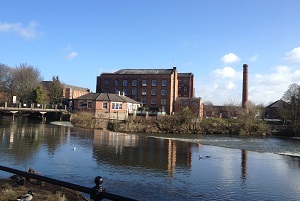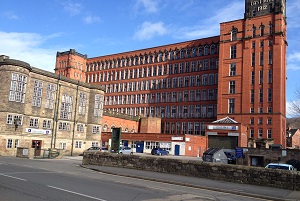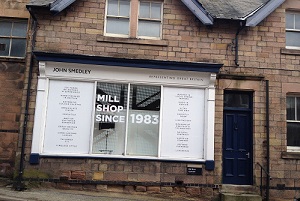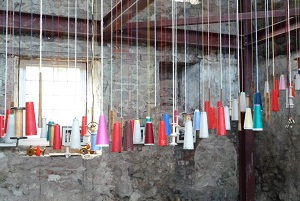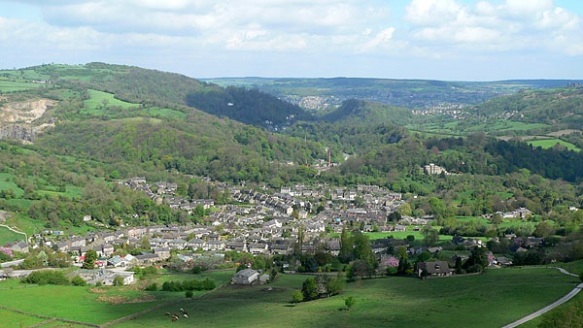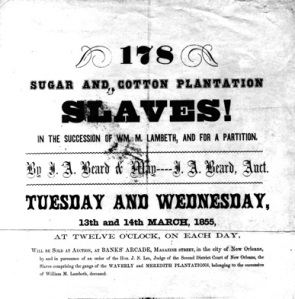A tour through the Derwent Valley Mills World Heritage Site
A few weeks back on a fine day in late February, Lowri and I were lucky enough to be given a guided tour of some of the key sites of the Derwent Valley Mills World Heritage Site by its Director, Mark Suggitt. This proved an excellent way to discuss the project with Mark and start thinking about the sites and landscapes of Derbyshire’s cotton connections.
We met at Derby’s famous Silk Mill before driving a mile or so up the river valley to the first of the cotton mill sites, Darley Abbey. This well-preserved site was first developed in the 1780s by the Evans family, an established landed family with iron and banking interests It was then only a small, though industrialising, village – the Evans family lived in the Abbey surrounded by parkland. Powered by the River Derwent, the early mills produced yarn from raw cotton supplies sourced from the slave-worked plantations of South America, particularly Brazil, the Caribbean and the southern states of America (Lindsay, 1960; http://www.derwentvalleymills.org/). In a later visit to Derbyshire Record Office in Matlock we identified source materials for further study of these connections but their condition means they will be a challenging read!
Belper & the Strutt family
We drove on a few more miles up the valley to the now substantial town of Belper. It was here that the Strutt family, by 1815 the largest producers of cotton yarn in England, developed a series of mills from the late 1770s. These also sourced their much larger requirements for raw cotton in the late 18th and early 19th centuries from slave-worked plantations in South America, the Caribbean and the southern states of America, with smaller amounts coming from India (Fitton and Wadsworth, 1958). Our subsequent visit to the Derbyshire Record Office revealed a magnificent though water damaged raw cotton ledger confirming these sources. We will be examining these and additional related correspondence further in future archive visits.
The most prominent remains of the Strutt family mills are North Mill (rebuilt in 1804) and East Mill (1912). North Mill now houses the Derwent Valley Visitor Centre, which we hope to include in one of our Peak District visit days. Some textiles are still produced in Belper by Courtaulds who make lingerie there at West Mill.
Belper was also a small rural village, with a nail industry, before the Strutts started building there but grew rapidly into the second largest town in Derbyshire by 1801 (Fitton and Wadsworth, 1958). Besides the mills and associated industrial premises, the Strutts developed many new streets of houses for the mill workers and their families – Mark showed us round several streets of different housing types. In the early days, mill workers were mainly children; their fathers constructed and maintained the mills and their mothers picked the raw cotton clean.
From Smedley’s Mill…
We next headed further north to the Lea Valley, just off the main Derwent Valley. Our destination was the more secluded Smedley’s Mill, the site of which was originally developed for cotton spinning by the Nightingale family (a member of whom was Florence Nightingale). The Smedley family took over in the early 19th century and began producing cotton and wool yarns. High quality knitwear is still produced on the site and sold via a rather tempting factory shop! The company has its own archive and archivist and we plan to make contact (http://www.derwentvalleymills.org/).
…to Cromford, site of the world’s first water-powered cotton spinning mill
Our last stop for the day was Cromford, home to the world’s first water-powered cotton spinning mill and probably the most famous place in the Derwent Valley Mills World Heritage Site. There is much to see at Cromford, including the original mill and its associated buildings, Masson Mill, a larger site developed later to harness the power of the Derwent directly, and the village itself with its specially-designed workers’ housing, market place and substantial inn. While the first cotton factory developments were made by the partnership of Richard Arkwright, Jedediah Strutt and Samuel Need, a wealthy hosier from Nottingham, the Arkwrights later took over. They amassed an enormous industrial fortune and moved into banking and landed property. Unfortunately there are few surviving records relating to the Cromford mills but we hope to piece together what we can from a range of sources.
Cromford will certainly be included in our Peak District day visits. Rooms are available at Cromford where we could meet and have lunch on our visit days, either next to the Cromford Canal, an important route south to traders and markets in the Midlands and London, or in the main old mill complex. Cromford also provides an opportunity for our project to engage with the Arkwright Society whose volunteers guide visitors around the site. We might also use the exhibition space available in the old mill building to display the project’s heritage legacy materials. An interesting cotton-inspired exhibition has run there in the past during the special Derwent Valley Mills Discovery Days. It would be great to take part in some of these.
The trip revealed a host of possibilities for the project in terms of cotton mills and businesses to study in the archives, sites for our groups to visit and places where we might make a new contribution to public histories of global cotton.

